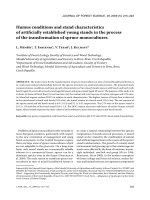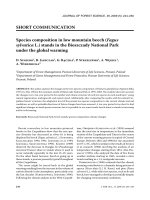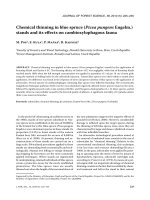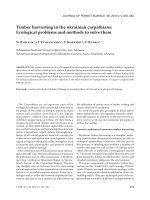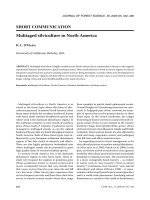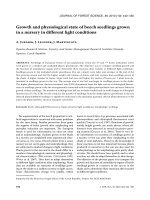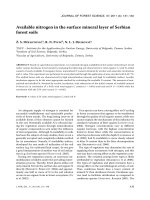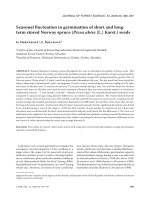Báo cáo lâm nghiệp: "Species composition in low mountain beech (Fagus sylvatica L.) stands in the Bieszczady National Park under the global warming" doc
Bạn đang xem bản rút gọn của tài liệu. Xem và tải ngay bản đầy đủ của tài liệu tại đây (479.78 KB, 7 trang )
244 J. FOR. SCI., 55, 2009 (5): 244–250
JOURNAL OF FOREST SCIENCE, 55, 2009 (5): 244–250
Recent researches in low mountain primeval
forests in the Carpathians show that the tree spe-
cies diversity has decreased as silver fir is being
displaced by beech (Fagus sylvatica L.) (J,
K 1990, 1991; J et al. 1994;
J, S 1995). K (1989)
observed the decrease in Douglas fir (Pseudotsuga
menziesii Franco) share in stands where it used to
occur naturally especially in the last 15–25 years.
On the other hand, however, beech is going up in
these stands, a process presently typical throughout
all the Carpathians.
The cause might be traced back to the global
warming resulting from the increase in the volume of
carbon dioxide in the atmosphere, particularly over
the last decades (F, J 1996).
Following the climate analysis in the West Carpath-
ians, O-S et al. (1994) assessed
that the total rise in temperature in the immediate
vicinity of the Carpathians and Tatras in the course
of the current warming process is typical of Central
Europe. Between 1881 and 1990 the rise amounted
to 0.9–1.3°C, which is similar to the results of J’s
et al. research (1986) involving the analysis of air
temperature changes starting from 1851. Also P-
(1995), who analyzed the data of five Swiss
weather stations starting in 1863, revealed a clear
trend resulting in a 1.3-centigrade increase.
D (1998) contends that the climate
warming contributes to a dramatic dying process of
spruce (Picea abies [L.] H. Karst.) and pine (Pinus
sylvestris L.), while other tree species, such as fir and
beech, have managed to develop successfully despite
the changing environmental conditions.
SHORT COMMUNICATION
Species composition in low mountain beech (Fagus
sylvatica L.) stands in the Bieszczady National Park
under the global warming
D. S
1
, R. J
1
, G. R
1
, P. S
1
, A. W
1
,
A. W
2
1
Department of Forest Management, Poznan University of Life Sciences, Poznań, Poland
2
Department of Game Management and Forest Protection, Poznan University of Life Sciences,
Poznań, Poland
ABSTRACT: e author analyzes the changes in the tree species composition of Dentario glandulosae-Fagetum Klika
1927 em. Mat. 1964 in the mountain stands of Bieszczady National Park in 1993–2003. e analysis takes into account
the changes over a ten-year period in the number and volume structure of each tree species in each stand layer: young
natural regeneration, undergrowth, and mature stand. Additionally, after comparing the results with the natural Car-
pathian forests’ structure, the adaptation level of the present tree species composition to the current climate and soil
conditions, as well as probable directions of future changes have been assessed. A ten-year period is too short to find
significant changes in stand species structure but it is possible to see some trends: beech share in stands is increasing
and fir is decreasing.
Keywords: Bieszczady National Park; beech stands; species composition; climate changes
J. FOR. SCI., 55, 2009 (5): 244–250 245
e aim of this work is to evaluate the change in
species composition in low mountain beech for-
ests in the Bieszczady Mountains and to compare
the current species composition with the species
composition of primeval beech forests in the Car-
pathians.
Area and method of research
e research area was located in the Bieszczady Na-
tional Park (BNP), in south-eastern Poland (Fig. 1).
Together with Uzansky National Park (Ukraine) and
Poloniny National Park (Slovakia), it is the central
part of the International Biosphere Reserve East
Carpathians, the first trilateral reserve which was
established under the UNESCO-MaB (Man and the
Biosphere) programme. With the area of 29,201 hec-
tares, the BNP spans the most interesting ranges of
the Bieszczady Mountains in terms of its landscape
qualities as well as unique fauna and flora. Climatic
conditions are typical of mountains regions: aver-
age yearly temperature is between 2°C (higher than
1,075 m above sea level) and 4°C (650–1,075 m
a.s.l.), average yearly precipitation is about 1,100 to
1,200 mm (max – July: 150–170 mm; min – January:
70 mm), snow is staying about 120 days per year.
e database for this study includes:
– e results of
J’s (J, K-
1990, 1991; J, S
1995; J et al. 1991, 1994, 1995, 2000) and
K’s (1989) research in Carpathian primeval
forests.
– e results of measurements carried out in the
BNP in 1993 by the Bureau of Forest Management
and Geodesy (Przemysl Department) in the test
plots of the statistic-mathematical forest inven-
tory and control system (BULIGL O/P
1996).
– e results of measurements repeated in 2003 in
100 test plots of this system in the lower-mountain
zone (pure beech stands).
e 100 test plots were selected randomly from
the net of 362 permanent, circular test plots (0.04 ha
each) which were localized in the nodes of a regular
500 m
2
net (Fig. 2). Only pure beech stands on moun-
tain forest site in low mountain zone – Dentario
glandulosae-Fagetum-typicum – were taken into
consideration (Fig. 3).
Measurements were carried out according to the
methodology of the statistic-mathematical forest
inventory and control system that has been widely
Fig. 1. Research area – Bieszcza-
dy National Park
Fig. 2. Location of test plots
246 J. FOR. SCI., 55, 2009 (5): 244–250
adopted in Poland (R 1989; P
1993, 1995). e acquired field data were analyzed
to show changes in the number of trees and stands
volume of species composition in beech forests in
the Bieszczady Mountains in 1993–2003. All forest
layers were taken into account: mature stand (trees
with dbh > 7 cm), undergrowth (trees with height
> 0.5 m and dbh < 7 cm), and natural regeneration
(trees and seedlings smaller than 0.5 m). Results were
compared with historical stands structure similar to
primeval Carpathian beech forests showed in Korpeľ
and Jaworski works.
RESULTS
e research shows that the most important tree
species in beech forests in the Bieszczady Mountains
are beech, fir (Abies alba Mill.) and sycamore (Acer
pseudoplatanus L.). e analysis of the structure of
the number of trees (Fig. 4) may prove that in the
species composition of a mature stand (in 2003)
beech is the dominant species (88.7% – 606 trees/ha),
while as an addition there is fir (5.7% – 39 trees/ha),
and sycamore (3.8% – 26 trees/ha). Other tree spe-
cies amount to less than 3%.
During the 10-year control period (1993–2003)
the percentage of these species did not noticeably
change: beech – 87.4% (608 trees/ha), fir – 6.0%
(42 trees/ha), sycamore – 4.1% (28 trees/ha). e
absolute decrease in the number of trees was 12 trees
per ha, which shows a slight advantage of a natural
tree loss (loss = 42 trees/ha/10 years) over the growth
of trees over a 7-cm dhb threshold (growth = trees
per ha/10 years).
In the analysis of the species structure according
to the tree volume (Fig. 5) one can note the share
of fir, being almost twice as high as its share in the
total number of trees (in 2003: 9.5% – 49.51 m
3
/ha).
Fig. 3. Location of beech stands in Bieszcza-
dy National Park (source: P,
K 1999)
Percentage of beech
in tree stand
80–100%
50–70%
30–40%
10–20%
< 10%
non-forest areas
5 km
-100
0
100
200
300
400
500
600
700
1993
2003
Dry trees_93
Dry trees_03
Loss trees
Ingrowth trees
Trees/ha
Beech Sycamore
Fir others
-100
0
100
200
300
400
500
600
700
1993
2003
Dry trees_93
Dry trees_03
Loss trees
Ingrowth trees
Trees/ha
Beech Sycamore
Fir others
Fig. 4. Species structure in low mountain
zone beech forests in the Bieszczady
Mountains according to the number
of trees (for years: 1993–2003) and
compared with dry trees, loss ones and
ingrowth trees
Others
(Trees/ha)
–
J. FOR. SCI., 55, 2009 (5): 244–250 247
At the same time, as much as 15% of the whole fir
population in the examined beech forests is dry-
wood, whose share exceeds 60% of the total dimen-
sion of dry-wood (17.14 m
3
/ha). Among live trees
the dominance of beech is still definite – 84.9%
(441.26 m
3
/ha), while the share of sycamore amounts
to 3.5% (18.27 m
3
/ha).
Comparing the 2003 volume structure of the
examined tree stands with the 1993 results reveals
the lack of any essential changes in the species com-
position of Bieszczady low mountain beech forests
(the share of beech was 84.2% – 339.57 m
3
/ha,
fir – 10.0% – 40.26 m
3
/ha, and sycamore – 3.5%
– 14.27 m
3
/ha).
Fig. 6 shows species structure of primeval beech
stands according to stand volume. Beech dominates
strongly but its share is a little lower than in the test
plots (77%). Moreover, as an addition there is fir
(13%), sycamore (3%), and spruce (6%).
e species composition of natural regeneration in
the examined beech forests basically adheres to the
parent stand (Figs. 7 and 8). Its structure consists of
almost only three tree species: the dominant beech
and fir, and sycamore as an addition. As for under-
growth (Fig. 7), however, a higher share of beech is
noticeable (2003: 91.5% – 2,666 trees/ha) and there
is nearly no sycamore (0.3% – 9 trees/ha). e share
of fir is 8% (233 trees/ha). As for natural regeneration
(Fig. 8), much less beech is to be found there (70.4%),
and the dominant additional species is sycamore
(18.7%), leaving fir far behind (4.8%).
In comparison with the 1993 results, some general
changes in the composition of Bieszczady beech for-
ests’ natural regeneration can be found – the changes
that may contribute to the composition of the mature
tree stand in the near future. Both the undergrowth
and the natural regeneration reveal the increasing
number of beech trees (2.0% and 14.5% respectively).
At the same time, the share of additional tree species
lowered notably, especially with fir in the natural re-
-100
0
100
200
300
400
500
1993
2003
Dry trees_93
Dry trees_03
Loss trees
Ingrowth
trees
m
3
/ ha
Beech Sycamore
Fir others
beech
77%
fir
13%
sycamore
4%
spruce
6%
0
500
1,000
1,500
2,000
2,500
3,000
3,500
1993 2003
Year of measurement
Trees per 1 ha
Beech Fir
Sycamore others
Fig. 6. Tree volume structure in the Carpathian beech primeval
forests (according to Jaworski’s researches in the Babia Góra
NP, Bieszczady NP and Gorce NP)
Fig. 5. Species structure in low mountain
zone beech forests in the Bieszczady
Mountains according to the volume of
trees (for years: 1993–2003) and com-
pared with dry trees, loss ones and
ingrowth trees
Fig. 7. Species structure of undergrowth in low mountains
zone beech forests in the Bieszczady Mountains (for years:
1993–2003)
Spruce
6%
Sycamore
4%
Fir
13%
Beech
77%
–
(m
3
/ha)
Others
(Trees/ha)
Others
248 J. FOR. SCI., 55, 2009 (5): 244–250
generation (by almost 50%) and sycamore – mainly
in the undergrowth (by 70%).
e species structure of primeval beech forests
generally consists of three tree species (Figs. 9 and
10). e dominant species is beech, with only 57%
share in the natural regeneration (Fig. 10), but a
90% share in the undergrowth (Fig. 9). e main ad-
ditional species is fir, with 25% share in the natural
regeneration and 8% share in the undergrowth. e
third place is taken by sycamore (17% in the natural
regeneration) or spruce (2% in the undergrowth).
CONCLUSIONS AND DISCUSSION
e research conducted in 2003 showed beech as
the dominant species in mature forest stands, with
a share of 88.7% in the number of trees and 84.9%
in the total stand volumes. Additional tree species
include fir (5.7% in the tree count and 9.5% in stand
volumes) and sycamore (3.8% and 3.5% respectively).
Other species’ total share (spruce, goat willow, aspen
poplar, mountain ash, hazel, mountain elm, ash) is
less than 2%.
According to Jaworski’s group, the primeval lower
mountain forests in plant association Dentario glan-
dulosae-Fagetum in Eastern Carpathians (Bieszczady
Mts.) are mostly composed of three tree species:
beech, fir, and sycamore (J et al. 1991, 1995,
2000), and in Western Carpathians (Beskidy Moun-
tains: Babia Góra, Gorce): beech, fir, and Norway
spruce (J, K 1990; J,
S 1995). e domination of beech in
the Bieszczady Mountains is much higher than in
the Beskidy Mts. Analyses by S (1998)
indicate that the mean share of beech amounts to
74.4% in Eastern Carpathians, and 54.5% in Western
Carpathians.
In comparison to the 1993 data, the tree species
structure of beech stands did not change: beech
share in total tree count was about 87.4% and in the
total stand volume – 84.2%, fir – 6% and 10% and
sycamore – 4.1% and 3.5% respectively.
e results do not confirm K’s observations
(1989); the researcher pointed out the essential de-
crease in the share of fir in Carpathian forests over
the last 15–25 years, accompanied by the increasing
share of beech. No explicit decrease in the share of
fir was also noticed across the neighbouring stands
in Ukraine in the Carpathians Natural Park (K-
, L 1993).
On the other hand, the analysis of natural regen-
eration indicates some trends that may contribute
to the future development of mature beech stands
in Bieszczady. Both in undergrowth and in natural
seedlings significant increase in the number of beech
(2.0% and 14.5% respectively) can be observed, while
the share of fir has decreased by 1.0% and 4.6%
0
20
40
60
80
100
1993 2003
Year of measurement
(%)
Beech Sycamore Fir others
beech
90%
fir
8%
spruce
2%
Spruce
2%
Beech
90%
Fir
8%
beech
57%
fir
25%
sycamore
17%
spruce
1%
Spruce
1%
Sycamore
17%
Fir
25%
Beech
57%
Fig. 10. Species structure of undergrown in Carpathian beech
primeval forests (according to Jaworski’s researches in the
Babia Góra NP, Bieszczady NP and Gorce NP)
Fig. 8. Species structure of natural regeneration in low moun-
tain zone beech forests in the Bieszczady Mountains (for years:
1993–2003)
Fig. 9. Species structure of natural regeneration in Carpathian
beech primeval forests (according to Jaworski’s researches in
the Babia Góra NP, Bieszczady NP and Gorce NP)
Others
J. FOR. SCI., 55, 2009 (5): 244–250 249
respectively. However, one may assume that the
10-year period is too short to link the results with the
climate change. Such doubts can be found in a paper
by F and J (1996). Moreover,
as T (1993) observed, mountain climate
shows relatively low susceptibility to temperature
changes. us, although general trends are similar,
the fluctuations are weak and may even show a re-
verse trend.
On the basis of presented results we can say:
– Today’s species composition of the BNP’s lower-
mountain beech forests is noticeably dominated
by beech, with an addition of fir and sycamore.
Such a composition is also typical of Carpathian
primeval forests.
– After the 10-year control period the species com-
position of mature forest stands did not reveal any
material changes that could be linked to global
climate changes. Only some evidence of the loss
in the fir volume and the increase in beech volume
was collected.
– However, the increasing share of beech, accompa
-
nied by a decrease in the share of fir, is typical of
the natural seedlings’ tier, especially of the wild-
ling. Nevertheless, it may not be unequivocally
considered as a permanent direction of changes in
the structure of the BNP’s lower-mountain beech
forests that would stem from the global climate
changes.
R e f e r ence s
BULIGL O/PRZEMYŚL, 1996. Wdrożenie statystyczno-
matematycznej metody inwentaryzacji i kontroli zasobów
leśnych. In: Plan Ochrony Bieszczadzkiego Parku Naro-
dowego. Operat ochrony ekosystemów leśnych. BULiGL
O/Przemyśl, Przemyśl.
DOBROWOLSKA D., 1998. Dynamika rozwojowa drze-
wostanów jodłowych na tle współczesnych badań. Sylwan,
4: 91–100.
FABIJANOWSKI J., JAWORSKI A., 1996. Kierunki
postępowania hodowlanego w lasach karpackich wobec
zmieniających się warunków środowiska. Sylwan, 8:
75–98.
JAWORSKI A., KARCZMARSKI J., 1990. Struktura i dynami-
ka dolnoreglowych drzewostanów o charakterze pierwot-
nym w Babiogórskim Parku Narodowym (na przykładzie
trzech powierzchni doświadczalnych). Acta Agraria et
Silvestria, Series Silvestris, 29: 31–48, 49–63.
JAWORSKI A., KARCZMARSKI J., 1991. Struktura i dynami-
ka drzewostanów o charakterze pierwotnym w Pienińskim
Parku Narodowym (na przykładzie czterech powierzchni
doświadczalnych). Zeszyty Naukowe AR w Krakowie 254,
Leśnictwo, 20: 45–83.
JAWORSKI A., SKRZYSZEWSKI J., 1995. Budowa, struktura
i dynamika drzewostanów dolnoreglowych o charakterze
pierwotnym w Rezerwacie Łopuszna. Acta Agraria et Sil-
vestria, Series Silvestris, 33: 3–37.
JAWORSKI A., KOŁODZIEJ Z., OPYD Z., 2000. Bukowe lasy
o charakterze pierwotnym jako model lasów przerębowych.
Acta Agraria et Silvestria, Series Silvestris, 38: 3–31.
JAWORSKI A., PACH M., SKRZYSZEWSKI J., 1995. Budowa
i struktura drzewostanów z udziałem buka i jaworu w kom-
pleksie leśnym Moczarne oraz pod Rabią Skałą (Bieszczady).
Acta Agraria et Silvestria, Series Silvestris, 33: 39–73.
JAWORSKI A., SKRZYSZEWSKI J., ŚWIĄTKOWSKI W.,
KACZMARSKI J., 1991. Budowa i struktura dolnore-
glowych drzewostanów o charakterze pierwotnym na
wybranych powierzchniach w Bieszczadach Zachodnich.
Zeszyty Naukowe AR w Krakowie, Leśnictwo, 20: 17–43.
JAWORSKI A., KARCZMARSKI J., SKRZYSZEWSKI J.,
ŚWIĄTKOWSKI W., 1994. Structure and dynamics of lower
subalpine timber stands of Carpathian Mts of primeval
character. In: Research and Management of the Carpathian
Natural and Primeval Forest. Reports from the Conference
of Association of Carpathian Natural Parks and Protected
Areas. Bieszczady National Park, Ustrzyki Górne, Poland,
11–12 October 1994: 23–39.
JONES P.D., RAPER S.C.B., BRADLEY R.S., DIAZ H.F.,
KELLY P.M., WIGLEY T.M.L., 1986. Northern hemisphere
surface air temperature variations 1851–1964. Journal of
Climate and Applied Meteorology, 25: 161–179.
KARCZMARSKI J., LORYŚ S., 1993. Charakterystyka budowy
i struktury oraz wybranych cech hodowlanych dolnore-
glowego jodłowego drzewostanu przerębowego w Kar
-
packim Państwowym Parku Przyrodniczym na Ukrainie.
Acta Agraria et Silvestria, Series Silvestris, 31: 81–95.
KORPEĽ Š., 1989. Pralesy Slovenska. Bratislava, Veda: 329.
OBRĘBSKA-STARKLOWA B., BEDNARZ Z., NIEDŹWIEDŹ
T., TREPIŃSKA J., 1994. Klimat Karpat w okresie global-
nego ocieplenia i prognozowane zmiany gospodarcze.
Problemy Zagospodarowania Ziem Górskich, 37: 13–38.
PRIMAULT B., 1995. Etude de différentes possibilités de
depouillement de données climatologiques: De lévolution
de la température et des précipitations de 1864 à 1990 à
cinqu stations météorologique. Schweizerische Zeitschrift
für Forstwesen, 146, 12: 181–199.
PRZYBYLSKA K., 1993. Badanie dynamiki procesów laso-
twórczych na podstawie stałych powierzchni próbnych
statystyczno-matematycznego systemu inwentaryzacji
i kontroli lasu. Roczniki Bieszczadskie,
2: 95–108.
PRZYBYLSKA K., 1995. Monitorowanie procesów zachod-
zących w drzewostanach Bieszczadzkiego Parku Naro-
dowego. Roczniki Bieszczadskie, 4: 254–255.
PRZYBYLSKA K., KUCHARZYK S., 1999. Skład gatunkowy
i struktura lasów Bieszczadzkiego Parku Narodowego. In:
Monografie Bieszczadzkie. Tom VI. Ośrodek Naukowo-
Dydaktyczny BdPN, Ustrzyki Dolne: 159.
250 J. FOR. SCI., 55, 2009 (5): 244–250
RUTKOWSKI B., 1989. Urządzanie lasu. Cz. I. [Skrypt dla
Szkół Wyższych.] Kraków, Akademia Rolnicza: 148.
SKRZYDŁOWSKI T., 1998. Odnowienia lasu w naturalnych
drzewostanach dolnoreglowych w Karpatach. Sylwan, 11:
43–54.
TREPIŃSKA J., 1993. Variability of mean air temperatures
in Zakopane-town (1896–1990). In: ZAVODSKA E. (ed.),
Proceedings of the 16
th
International Conference on Car-
pathian Meteorology, Slovakia – Smolenice, 4–8 October.
Bratislava, Geophysical Institute of Slovak Academy of
Sciences: 21–27.
Received for publication September 15, 2008
Accepted after corrections January 20, 2009
Corresponding author:
Ing. A W, M.Sc., Poznan University of Life Sciences, Department of Game Management
and Forest Protection, ul. Wojska Polskiego 71d, 60-625 Poznań, Poland
tel.: + 48 618 466 238, fax: + 48 618 487 865, e-mail:
Druhová skladba horských porostů buku (Fagus sylvatica L.) v Národním
parku Bieszczady v podmínkách globálního oteplování
ABSTRAKT: Autoři analyzují změny druhové skladby dřevin společenstva Dentario glandulosae-Fagetum Klika
1927 em. Mat. 1964 v horských porostech Národního parku Bieszczady v letech 1993 až 2003. Analýza je zaměřena
na změny počtu jedinců a objemové struktury všech dřevin a všech porostních etáží (přirozené zmlazení, podrost
a dospělé porosty) za desetiletou periodu sledování. Po srovnání výsledků s údaji ze strukturovaných přirozených
karpatských lesů byl formulován jednak odhad adaptační úrovně současné druhové skladby na současné klima a půdní
podmínky, jednak pravděpodobný směr budoucích změn v porostech. I když je desetiletá perioda poměrně krátké
období na identifikaci průkazných změn ve struktuře druhové skladby porostů, lze z výsledků identifikovat některé
trendy: zvyšování podílu buku a snižování podílu jedle v druhové skladbě.
Klíčová slova: Národní park Bieszczady; bukové porosty; druhová skladba; klimatické změny

